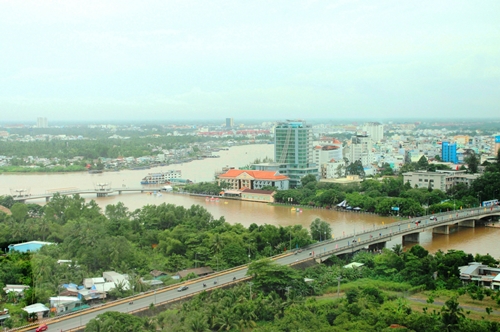
Electricity system
Currently, the Cantho electricity system supplied by the national electricity network (by the 220 KV Cai Lay-Tra Noc and Cai Lay-Rach Gia line) and by the Tra Noc thermoelectric power station (total power 193.5MW) ensures the supply of electricity for the city through the 110 KV line and 6 transformer stations.
Apart from these resources, the Prime Minister approved the construction project of O Mon Power Plant with 4 plants with a total power of 2,700MW including O Mon 1 of 600MW, O Mon 2 of 720MW; oil and gas electric plant of 660MW and O Mon 4 of 720MW whose construction is for completion in quarter IV/2016. Unit 1 of the O Mon 1 factory has been in operation since 2009.
Water distribution - urban drainage
Water supply: Currently, the city has 12 plants, and water supply stations in operation with a total design capacity of 166,320 m3/day, currently operating around 85% - 90% of its capacity. The percentage of households using drinking water in 2015 is 77.21%, of which the inhabitants in rural areas occupy the rate of 61.96%.
Drainage: The urban drainage system only ensures the evacuation of rainwater and wastewater in the main districts of the Ninh Kieu district. The drainage system is 23,509 m long with sewers of Ø 300-1,200 mm and 7,216 m of ditches of 200-500 mm. In general, the urban drainage system is weak and degraded while that in the center of the towns is not able to ensure the evacuation of water.
Traffic
Road traffic system: The city has 2,762.84 km of roads with a density of 2.3 km/km2 (or 698.548 km of roads with a density of 0.5 km/km2 not including communal roads); i.e. 123.715 km of national roads; 183.85 km of provincial roads; 332.87 km of district roads; 153.33 km of urban roads; 1,969.075 km of municipal roads; with hot mix asphalt concrete pavements occupying 3.98%, asphalt pavements occupying 26.26%, gravel pavements occupying 27.7%, gravel pavements occupying 17.44% and dirt roads for pedestrians and small load motorcycles.
Currently, the 6 national roads passing through Can Tho City are National Road 1A, National Road 91, National Road 80, National Road 91B, Hau River South Line, and Can Tho - Vi Thanh Line. Most achieved III, IV or urban road scale standards at Level II, III DB. In addition, the city currently has 11 provincial roads, at Level V, IV, III, and more than 383 km of roads in the district, of which 36/36 communes have had the road for the car towards the center.
Navigable traffic system: The waterway network is 1,157 km long with 619 km navigable for means of more than 30 tons of load (average depth > 2.5 m) including 6 lines administered by the central government (Hau Giang, Can Tho river, Cai San canal, Thi Doi canal, arroyo O Mon, Xa No canal) over a length of 132.88 km, navigable for means from 100 to 250 tons; 4 lines administered by the city (Thot Not canal, Ba Dam canal, Cau Nhiem arroyo, Ba Lang arroyo) with a total length of 81.45 km navigable for means from 30 to 50 tons; 40 lines administered by the boroughs and districts with 405.05 navigable km for means from 15 to 60 tons.
In addition, boats in the Hau River pass from the East Sea to Can Tho through Dinh An Port which allows vessels of 10,000 DWT and 20,000 DWT (carry ...) to access the river port systems, seaport d a convenient way.
Air transport: Can Tho International Airport, the largest in the Mekong Delta region, has been providing domestic flights since January 3, 2009, and international flights since 2010. This airport is the airport at level 4E by the standards of the ICAO. The port infrastructure has a 3000 m x 45 m runway that can accommodate B747-400 and equivalent aircraft; the landing system has five places to meet the 2 parking positions for the 747-400 ships and 3 places for the A321 ship... In addition, the passenger terminal has an area of 20,700 m2, with a capacity design capacity of 3 million passengers/year. Currently, Can Tho International Airport operates domestic flights and will soon open international routes to countries in the ASEAN region and Northeast Asia.
Works in the transport department:
The Can Tho Bridge spanning the Hau Giang River was built in September 2004 and put into operation on April 24, 2010.
The port system has been improved: the port of Can Tho (Hoang Dieu port) can accommodate boats from 10,000 to 20,000 DWT; the port of Tra Noc has 3 storage warehouses with a volume of 40.00 tons and 200.000 tons of goods per year, can accommodate boats of 2,500 DWT. Cai Cui port is the new port, after the completion of the construction of phase II, will be the largest port in the Mekong Delta, and is the national general port, the hub of the region (class I) belonging to Seaport No. 6 based on Vietnam's port system development planning to 2020 and 2030 direction approved by the Prime Minister. In general, the transportation system and transportation service works adequately meet the need of current socio-economic development and will receive city investment in the future for improvement.
Information and communication
Can Tho's modernized high-tech postal and telecommunications system is of perfect quality and connected to all cities, and provinces in the country and abroad.
Postal service: provided by 01 state company and more than 24 private companies with 35 postal centers, 48 communal posts, and 216 postal agencies, distribution points.
Telecommunications network: modernized and of perfect quality, the network properly meets the needs of socio-economic development and information and communication in the region with the implementation of modern services. 6 companies are currently involved in the telecommunication and internet sector in Can Tho. The IT industry is changing with 150 companies and 05 companies specializing in software development and digitization.
The city and borough, and district governments are connected to the broadband Internet and are connected to the data network used exclusively by the government; most of the research institutes, schools (universities, vocational schools, high schools, colleges), and hospitals have broadband internet access.
Other investment support services
In this city, apart from the state bank, branch in Can Tho with the function of state management of monetary and banking operations, there are currently 49 credit institutions with 235 places with banking transactions. Most major banks have offices and branches in Can Tho.
Source: Can Tho Portal - Translated by Hoang Dat












